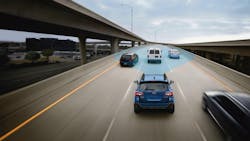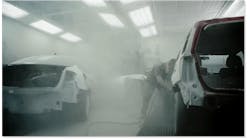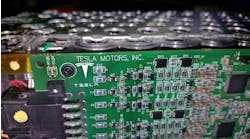More and more, MSOs are getting into the business of ADAS repair. I was on a panel at the most recent MSO Symposium with some people representing consolidators and other MSOs, all of which started a separate ADAS repair business operating under a different name. All indicated a strong inclination to perform proper repairs according to vehicle manufacturer repair procedures. Is that really the case with most MSOs and the rest of the industry? I fear that it is not. We see examples of people performing calibrations in parking lots, on non-level floors, and in areas with a lot of background and lighting contamination.
More Than Half of ADAS Calibrations Require Comebacks
The Insurance Institute for Highway Safety (IIHS) surveyed nearly 3,000 drivers about their repair experiences on cars with ADAS and found that while most consumers never had their assistance systems repaired, nearly 500 consumers who did typically had to have these systems repaired more than once. The worst offenders were blind-spot monitoring systems, with a respective 59% and 62% of owners who had their systems repaired making multiple trips to the repair shop specifically for recalibration. Naturally, these multi-visit percentages grew when factoring in repairs that involved crash damage and windshield replacement, indicating that it can be difficult to properly recalibrate these advanced systems following a crash. Those with crash-induced repairs were most likely to have persistent problems, while those who never had the systems recalibrated typically reported no problems. Notably, those who had repairs but never had the systems recalibrated were significantly less likely to encounter recurring problems as compared to those who repaired and recalibrated, signaling that some repaired but uncalibrated vehicles could falsely appear as functional. Additionally, the study found that routine, unrelated mechanical repairs sometimes led to problems with the ADAS systems, in turn requiring additional trips to the shop.
The OEM Provides the Standard. Who's Enforcing it?
Many of us in the industry are very concerned about this and feel there should be some sort of oversight, perhaps in the form of ADAS shop or business certification — or at least some mechanism — to verify that ADAS repairs comply with vehicle manufacturer repair procedures and standards. Most of us feel that the manufacturer guidelines and procedures should be and ARE the standard. Especially in today’s world of vehicle complexity, it’s hard to argue that anyone except the manufacturer who designs, builds, and tests the vehicle should be the one to set the standard. From their beginning, it has been I-CAR’s policy that the vehicle manufacturer repair procedures are the industry’s standard. I believe most repairers who choose the path of proper and safe repairs want to be differentiated from those who don’t. And we want our customers to recognize that.
Our industry has traditionally been slow to respond to significant change, often taking two or more years before processes and pricing normalize. And too often, standards are watered down. When I-CAR Gold was created, the requirements were modest. Over the years, the requirements have increased. Though some argue that although a shop may be I-CAR Gold, it doesn’t necessarily prove that it has the proper equipment, nor that it performs proper repairs. Even many OEM collision repair certification programs were “soft” when they first started appearing, in terms of levels of equipment, training, and process requirements. Thankfully, in recent years many programs are increasing the expectations and requirements. Some OEMs have stated that their goal is to verify that each repair is performed properly according to their certification requirements and repair standards.
How Do We Differentiate Those Doing the Job Properly?
There are currently many people who are dedicated to getting this new ADAS portion of our collision repair industry “right.” And we wish to see it happen promptly. There is so much at stake, especially in terms of vehicle occupant safety. Again, we see many examples of calibrations being performed improperly, especially by mobile people performing calibrations in environments that are NOT in compliance with OEM procedures. It leads to the question, “How do we differentiate those who do it right versus those who don’t?” And, “How do we make it apparent to the consumer who ultimately deals with any negative consequences?” Plus, the insurer who may be compensating or reimbursing for ADAS work needs to know how to tell the difference.
Many entities have worked on identifying typical processes and procedures. For example, the CIECA Calibration committee developed a calibration flow chart, based on OEM repair procedures and how they are employed within a shop environment. That led to setting up methodologies of transmitting supporting documentation electronically. SAE, CIC, ADAPT, SEMA, and many other entities and conferences have had discussions or presentations on various forms of the topic. Ford and Rivian both offer an ADAS shop certification, which resides separately but next to their collision certification. Most notably, I-CAR is currently working on the topic, which could potentially lead to a form of accreditation or verification or certification.
Is Certification the Answer?
Many of those people engaged in the issue lean toward some form of shop certification. If one considers a shop, or individual, certification that is generic to all or most vehicle brands it becomes very complicated. For example, when considering the shop floor size and variance in how level it is, different vehicle manufacturers have different requirements and different ways of measuring. To develop a plan, should the most stringent specifications be used? Should there be some allowance that accommodates most, or all but the most stringent? And of course, there is the temptation to accommodate the masses and set standards that most businesses could comply with so that it doesn’t become too difficult or expensive to comply.
Many of us, including me, say that the only standard we truly have is the vehicle manufacturer repair procedures. That has been I-CAR’s standard since their beginning. And this sophisticated vehicle technology does not lend itself to allowing us to become “amateur engineers” and develop any standards short of OEM. “Sorta-certification” isn’t enough. Let’s get this one right, for the safety and good of us all.



